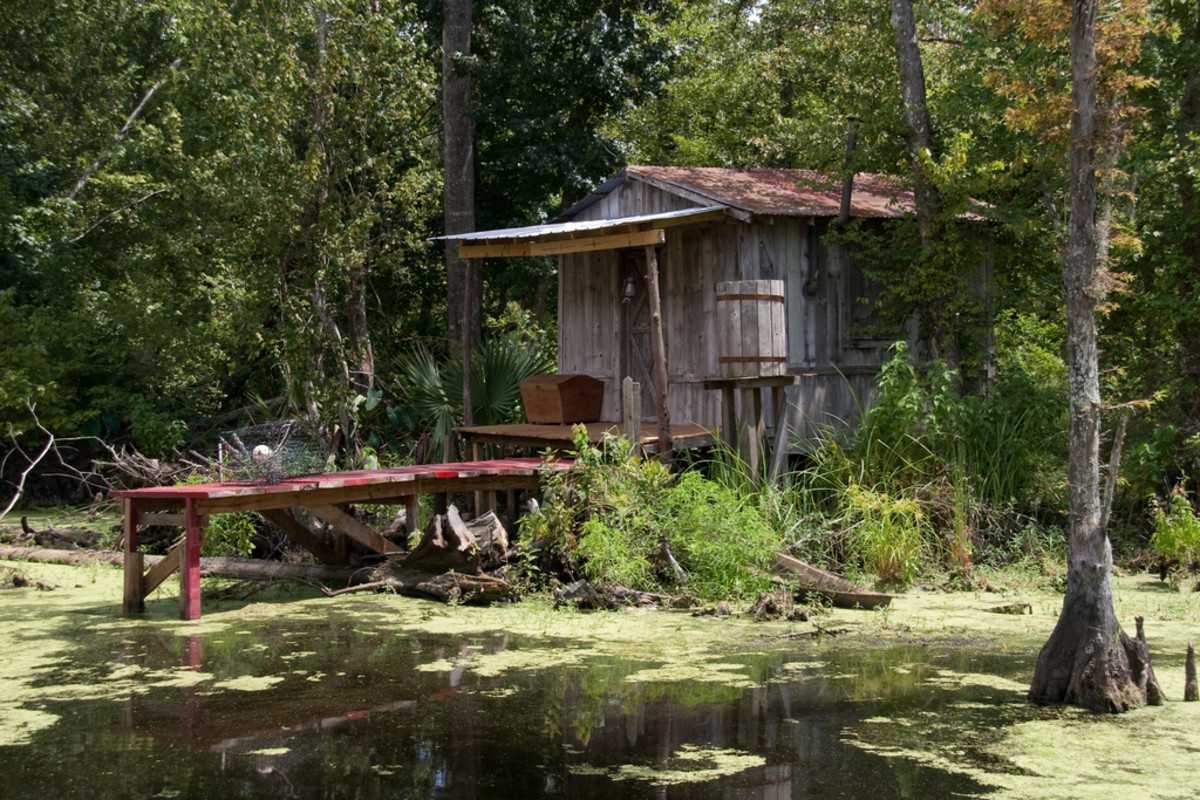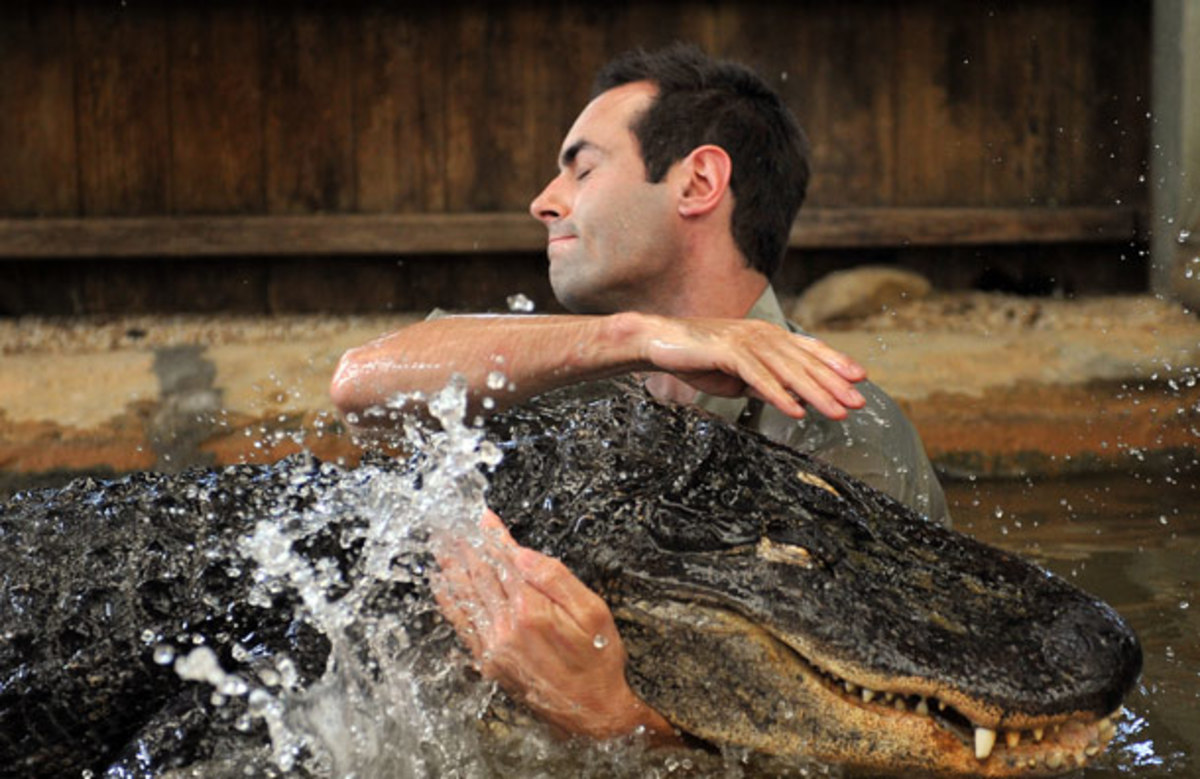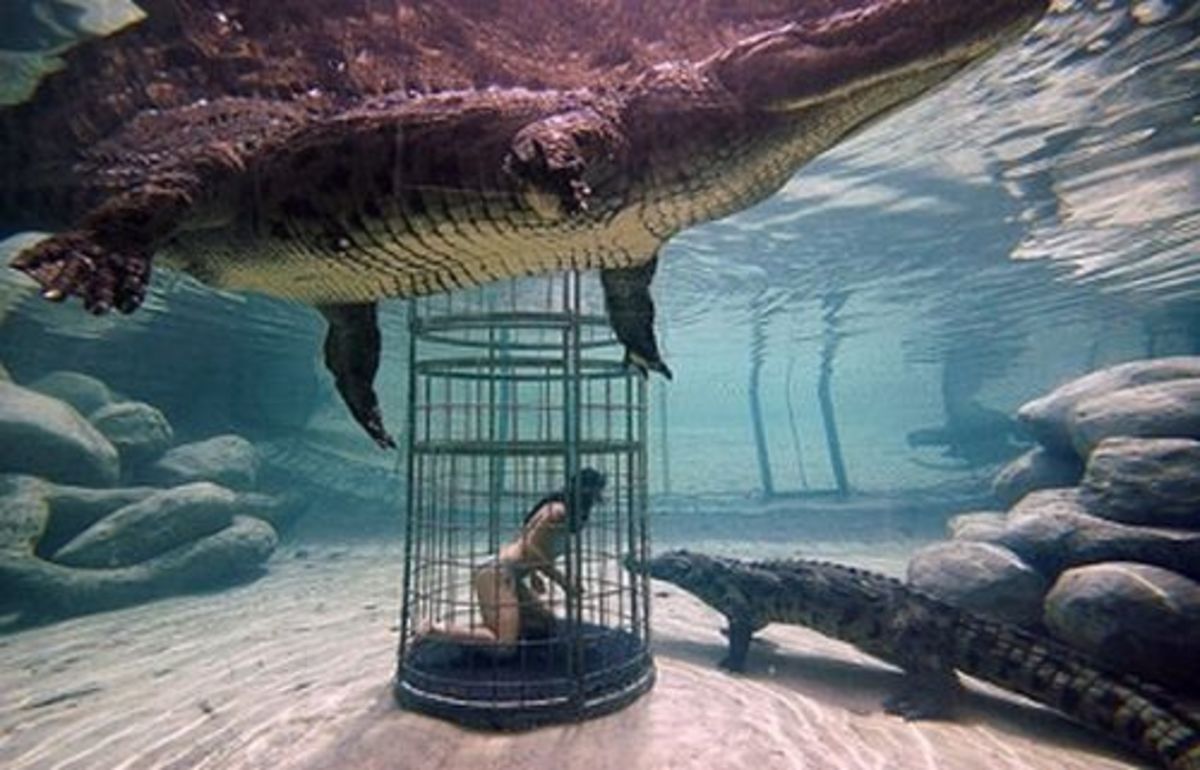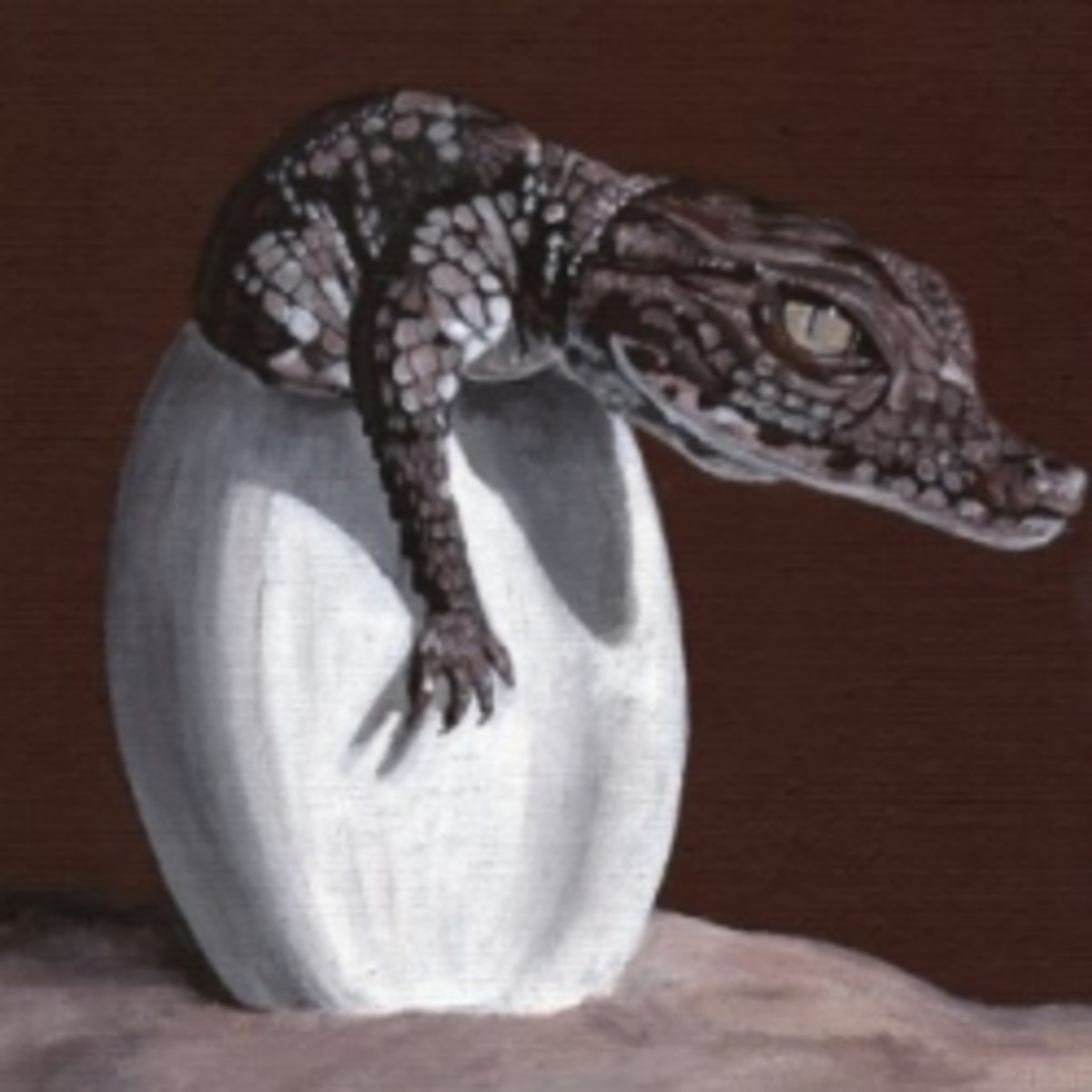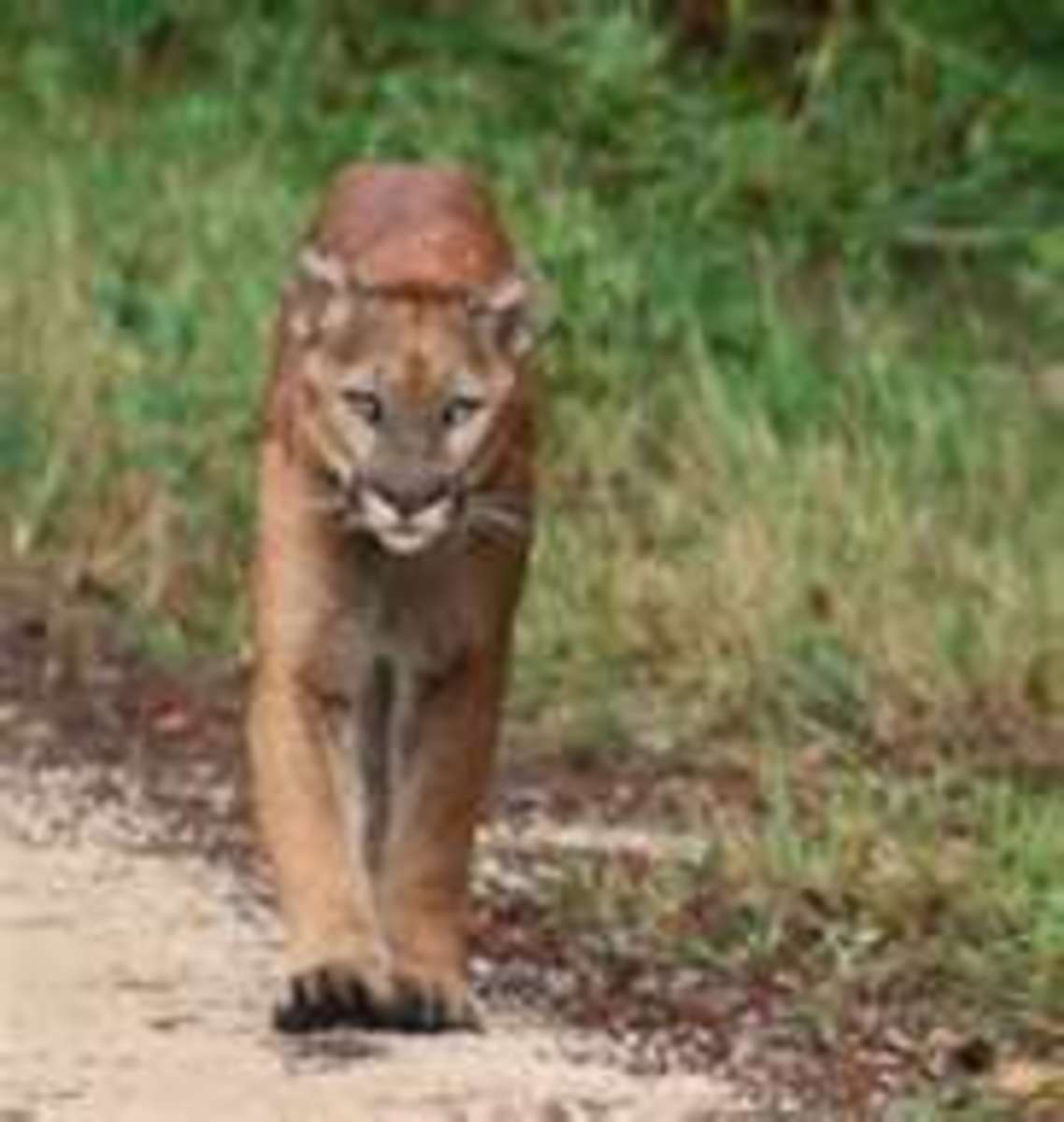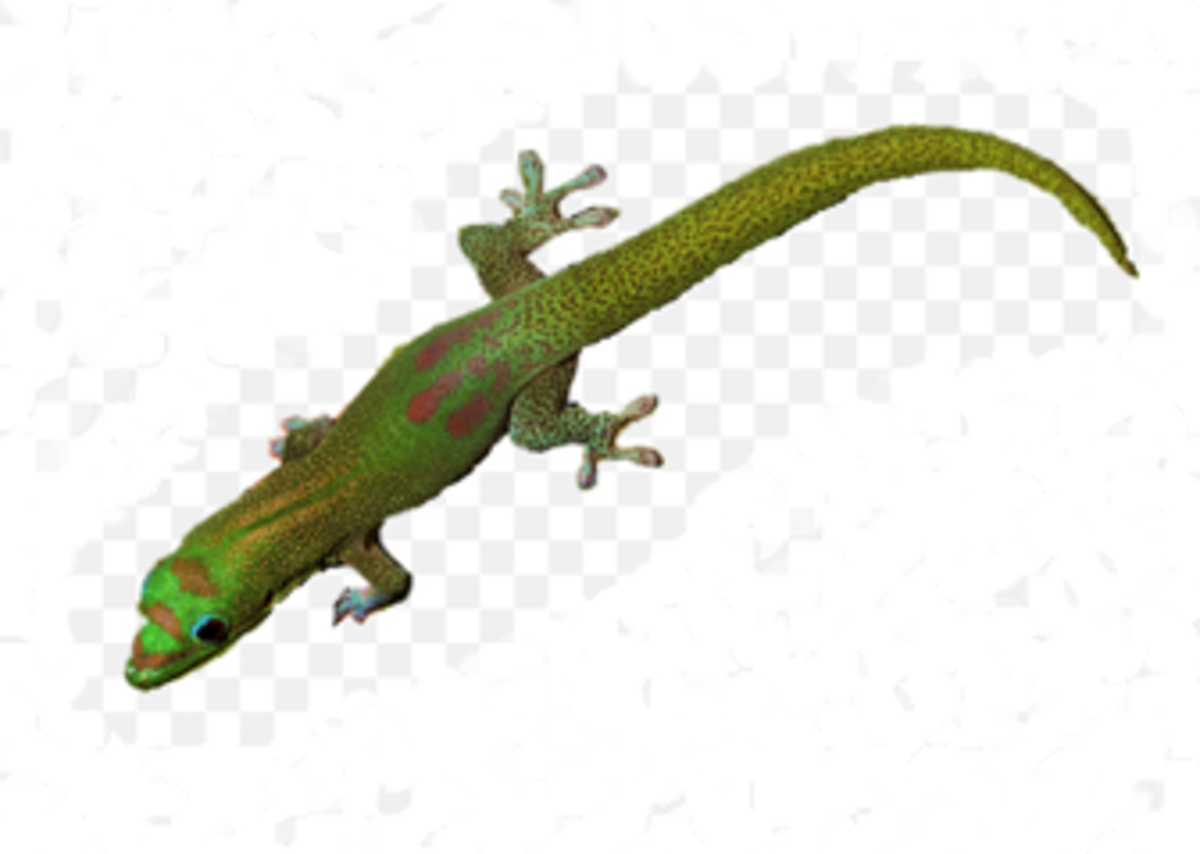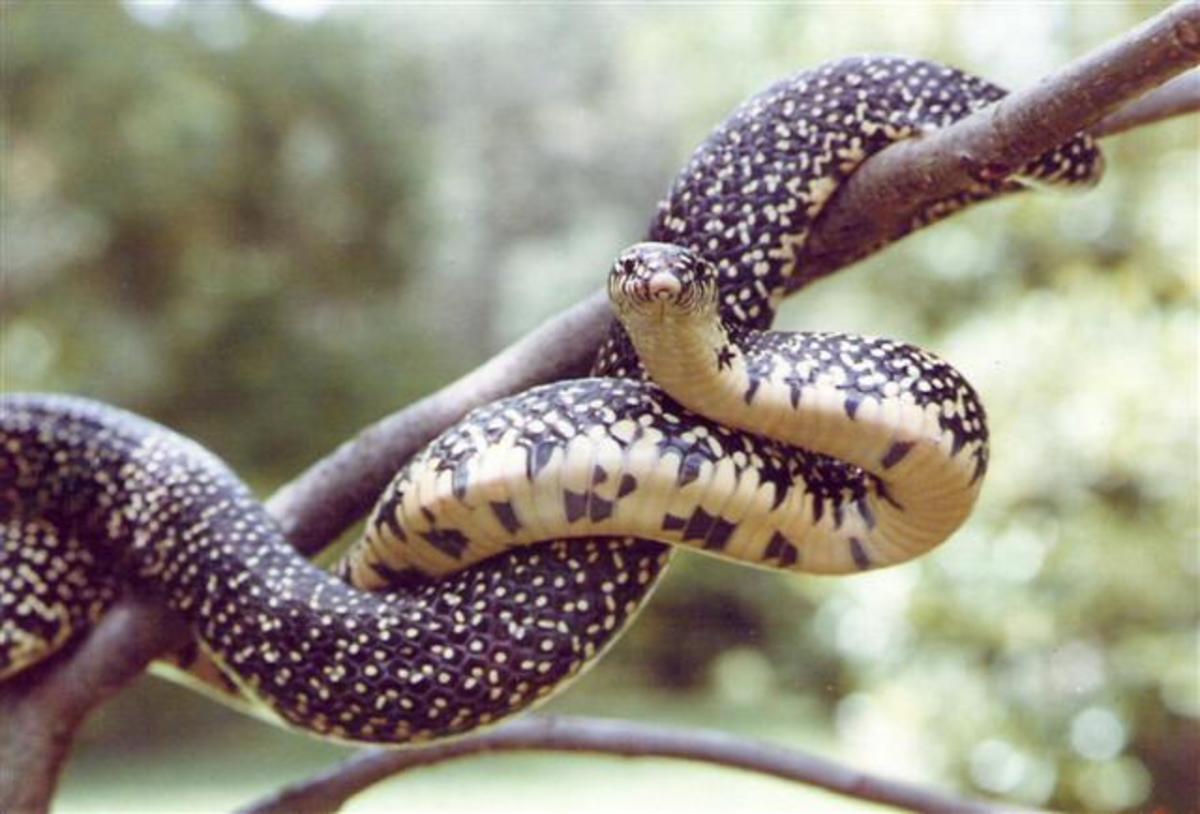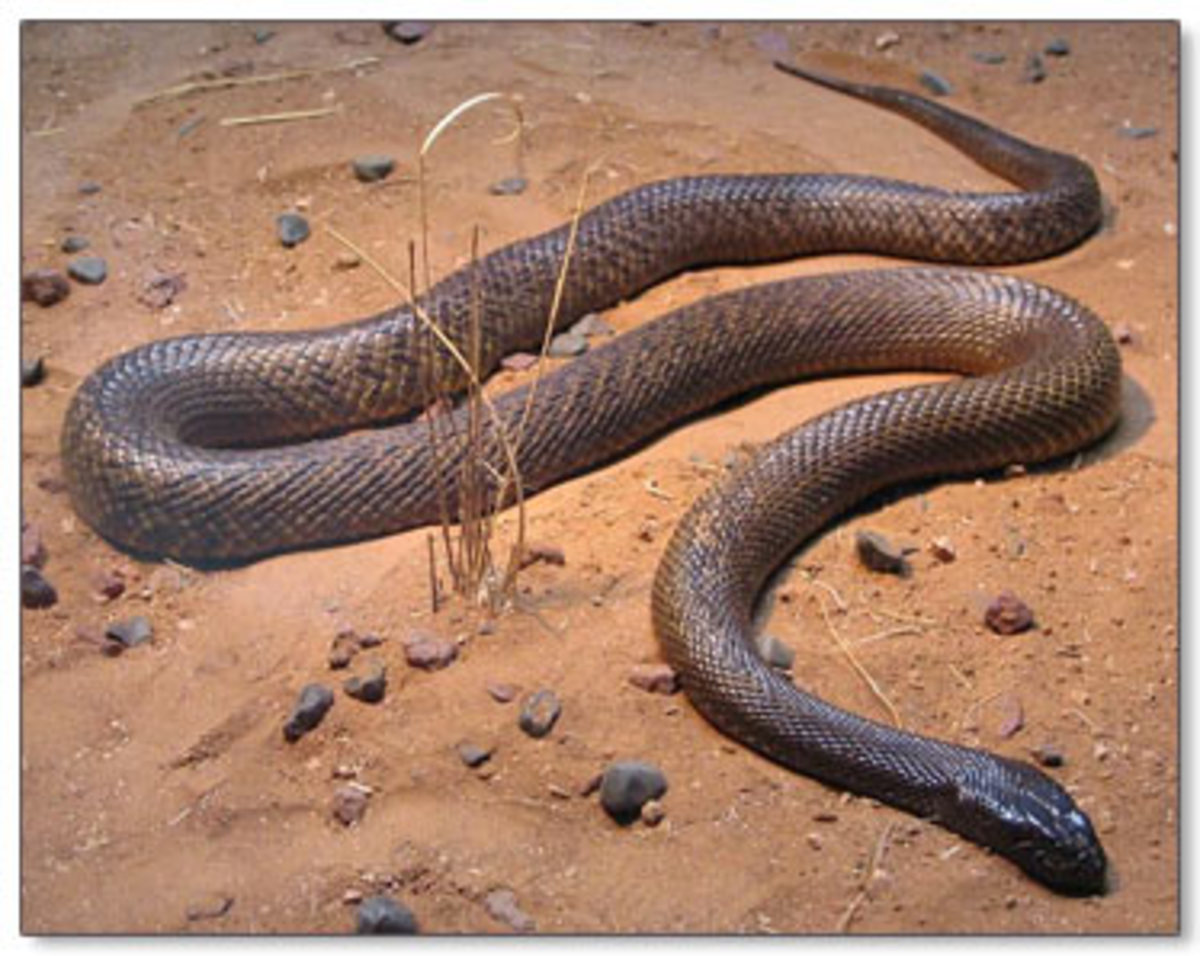Alligators of Florida
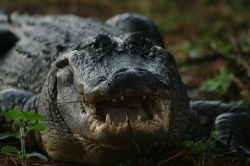
The Ancient Alligator
The alligators have been around for more than 200 million years and are native to only two countries. The U.S. and China. These are fantastic creatures. Alligators live in all areas of Florida and all of Louisiana and parts of Georgia, Alabama, Mississippi, South and North Carolina, Texas, Oklahoma and Arkansas. There are over a million alligators in each of Florida and Louisiana. Alligators in the wild are believed to live 35 - 50 years. We also have the American Crocodile in the keys and the far south of the state. Florida is the only place where both alligators and crocodiles live together.
I shoot video of what I see so you will find mini-movies throughout my Florida lenses. Shooting video of alligators is a very slow, patient activity. In other words I do a lot of standing around waiting for an alligator to move. This patience has it's own rewards as I have watched and video taped many creatures I would not have seen if I had just walked through the preserves. I put these videos on their respective lenses. I've been able to shoot some interesting video when the alligators had decided to move. You'll find the best on this lens. I hope you enjoy it!
For more on alligators as well as other creatures found at Wakodahatchee Wetlands preserve in Florida visit the Friends of Wakodahatchee Wetlands forum
Please note: This page is loaded with graphics and video. Please be patient while it loads.
All photos copyright by Gilbert & Vicki Henry
On The Move
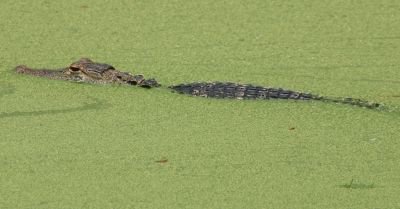
History

What does the name "Alligator" mean and where did it come from?
In The Travailes of an Englishman, published in 1568, Job Hortop says that "in this river we killed a monstrous Lagarto or Crocodile." This killing gives rise to the first recorded instance of alligator in English. Alligator, which comes to us from Spanish el lagarto, "the lizard," was modified in pronunciation and form in several ways before taking on the form alligator. The earliest recorded form of alligator that is similar to ours appears in Shakespeare's Romeo and Juliet (First Folio, 1623): "In his needie shop a tortoyrs hung,/An Allegater stuft."
From Answers.com?
Prehistoric Alligators & Crocodiles
Alligators and Crocodiles have changed very little from prehistoric times. "Crocodiles were an offshoot of the archosaurs, the "ruling lizards" of the Triassic period that preceded the dinosaurs. To simplify matters greatly, by about 200 million years ago, archosaurs had evolved into three separate reptile families: dinosaurs, pterosaurs (flying reptiles), and crocodiles." (1)
Crocodiles lived side by side with dinosaurs and survived the K/T Extinction which killed off the dinosaurs and 95% of all live on Earth.
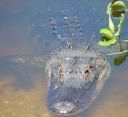
Are alligators endangered?
Alligators have been off the U.S. endangered species list since 1987 and have reached such high numbers that they must be managed for conservation and safety reasons. Eggs are collected from the wild for the farms. In Louisiana, when the animals are about 1 year old, 17 percent are mandated by state law to be returned to the wild. Louisiana is the world's top producer of farm-raised American alligator hides for the classic leather market, which accounts for about $38 million a year.
Excerpt from Except from Berkshire Publishing
Questions from Readers.
Send your questions to: WebCat
Q: Do alligators have ears?
A: Alligators ears have slits that close when under water. The ears opening is at the back of an alligators throat behind the palatal valve. They have to close this valve to open their mouths under water. If they open this valve under water then the water will run into their lungs. Yet to eat they have to open the valve. That's why alligators swallow food with their head out of the water. See: Alligators unique sensory adaptations.
Q: How fast does an alligator snap its jaws?
A: Really, really fast. Check out the videos titled "Snap & Hiss"
Q: Are alligators born with teeth?
A: Yes. They are little miniatures of their parents with teeth, eyesight and hearing for hunting.
Q: How does an alligator sink and then float in water
A: They do it with air. They use muscles to move their lungs around inside their body to roll or bring one part of their body up higher or lower in the water. See: How alligators manage to move so silently and smoothly in the water.
Q: Where can you see alligators in Florida?
A: Everywhere. To see alligators in the wild there are many preserves that they like to hang out at.
This is an ongoing journal of events at Wakodahatchee Wetlands but also lists other preserves as well as what to take with you to the preserve and what you may expect to see at different times of the year.
Physical Characteristics

How big do alligators get?
Female's rarely reach more than 9 feet but males can reach 14 feet.
"Alligators are about 10"-12" in length when they are hatched from eggs. Growth rates may vary from 2" per year to 12" per year, depending on the type of habitat the alligator is living in and the sex, size an age of the alligator. Growth rates slow down as the alligators become older. Male alligators will grow faster and larger than females. Females can grow to approximately 9' in length and 200+ pounds. Males can grow to approximately 13'+ in length and attain 500+ pounds."
Louisiana Alligator Advisory Council
The longest recorded length for an alligator is 19' 2". This animal was trapped in the early 1900s in the State of Louisiana. Most wild alligators do not get above 13 feet in length and may weigh 600 pounds or more. Of course, this is just the "Official" record. There are many stories of larger alligators.
The average alligator will be about 5 to 8 feet long. These are breeding size and even though they aren't huge monsters they're the ones sitting on the nests and hanging around protecting the babies. See: "A little story about a mother alligator and her territory" below for video on a 6 foot female alligator displaying territory behavior in her small 'gator hole. I believe she has young close by and was telling everyone to stay clear.
Like most reptiles alligators continue to grow as long as they live. They grow about 1 foot per year until they reach 6 feet. Then they grow slower and start to grow wider.

Alligator teeth
Alligators swallow their food whole. The teeth of an alligator are conical shaped and are made for grabbing and holding, not for cutting. When dealing with larger prey, an alligator may shake its head or spin its body in order to tear off a piece small enough to swallow. Adult alligators have 80 teeth that they replace if they lose them. According to Texas Parks and Wildlife an alligator can go though 2,000 to 3,000 teeth in a lifetime.
How wide can an alligator open it's mouth?
I stood in the shelter of a sable palm while it rained one morning and watched an alligator enjoying the shower. This is the large female alligator that prefers to build her nest at the edge of the path every year at Wakodahatchee Wetlands. She has a broken tooth. I like this video because it shows the flap at the back of her mouth that closes off her throat. Alligators have to have their head above water to swallow. They'll often come to land to eat. I think part of this is also so that the prey doesn't get away. Great Blue Herons will also take a fish to land.
Yes, it is raining in this video. But it was a gentle rain and a sable palm was kind enough to shelter me. I love this video because it shows the palatal valve that blocks off the throat when the alligator opens his mouth under water.
Behind the palatal valve inside the alligators mouth are the trachea (called "glottis') which leads to the lungs and the oesophagus which leads to the stomach. The alligator closes the valve when it is under water so it doesn't get water into it's lungs. When the alligator is partially submerged with just it's eyes and nostrils above the water and it's mouth under the valve is closed to prevent water getting into it's lungs. He can breath because the nostrils opening into it's mouth is towards the back and behind the valve.

Alligator Hide
Alligator hide is used for handbags, belts, cowboy boots, attaché cases, and clothing. Alligator meat (mainly it's tail) is eaten.
Alligator farming programs run in Louisiana, Florida, Georgia, Texas and South Carolina, are done under close regulatory scrutiny and controlled commercial harvesting of alligators is actually positive for conservation.
Scaly Skin

"Like all reptiles, alligator skin is covered with rows of scales. The scales are made of keratin, the same protein that forms the human hair and fingernails. This thick covering protects the body from the effects of both water and sun. An alligator's body design is well adapted to life in an aquatic environment. Its eyes, ears, and nostrils are located on the top of the head, enabling it to breathe and sense its environment when almost totally submerged. The alligator's strong tail is moved from side to side to propel it through the water. The digits (fingers and toes) are webbed and its short but strong limbs are used as rudders when swimming."
Excerpt from the Los Angeles Zoo website. Unfortunately this individual page isn't there any more.
Alligators unique sensory adaptations
Tail
An alligators tail is very powerful. It is used for swimming and assists the alligator when it makes it's famous and startling leaps right out of the water. They also use their tail to clear mud and make their famous "gator holes". These are deeper areas in the marsh that continue to hold water during dry spells.
Feet
An alligator has five toes on it's front feet and four on it's hind. The claws are not sharp. The front feet are shaped a bit like a hand. The hind feet are longer. The hind feet can be seen in the video "The High Walk".
Ears and Nostrils
Alligators ears have slits that close when under water. This makes an alligators nose and ears waterproof. The nostrils connect to an alligators lungs by an opening in the back of the mouth behind the valve at the back of the throat.
Eyes
Alligators have night vision and see very well in near darkness. They also have a third eyelid that is transparent. This moves from front to back to cover the eye when swimming. An alligators oval-shaped pupils remain vertical to the horizon even when it's head is tilted. It is unknown if they see color but they have both rods (for night vision) and cones (for color and/or vision sharpness in daylight).
A special sense
The tiny dark dots on the 'gator's jaw look like freckles but they're actually very sensitive buttons called integumentary sensory receptors. These enable the animal to sense movement in the water, such as fish swimming nearby. Crocodiles have these all over their bodies.
http://www.crocodopolis.net/lwa_alligator.htm
I've watched alligators and I suspect that they can sense movement in the water from a great distance. Mother Alligators will also lay their heads on their nests as if they're listening (or feeling) for movement in the nest.
Locomotion
Alligators have several types of walk. This video shows the "high walk". They also have a belly crawl which they often use in stalking or hunting in the wetlands.
They may have a gallop which I haven't seen yet. From my reading it doesn't appear that people have seen this in alligators though it has been seen in crocodiles. The two species are very much a like so an alligator may be able to move this way. Maybe the terrain is different. It's not easy to get a solid base under your feet in a marsh.
Alligators also swim very efficiently and, in my opinion, this is their most beautiful method of movement.
And yes, they can jump up and catch a bird flying or sitting in on a branch. If I'm lucky someday I'll get a video of this remarkable and surprising action. People who've seen it always repeat the story with awe no mater how many months or years ago they've seen an alligator do this.
The High Walk
How alligators manage to move so silently and smoothly in the water.
A study by T. J. Uriona and C. G. Farmer of the University of Utah published a study in the Journal of Experimental Biology [http://jeb.biologists.org/cgi/content/full/211/7/1141]. The study has an impressive name: "Recruitment of the diaphragmaticus, ischiopubis and other respiratory muscles to control pitch and roll in the American alligator (Alligator mississippiensis)" Well what do you expect? It's a scientific journal.
The article starts out beautifully with:
"Although only semi-aquatic in their habits, crocodilians are adept at aquatic locomotion. They can stealthily adjust their position in the water without a ripple or noticeable muscular activity; they can float passively at the surface or sink and sit comfortably on the bottom. They are remarkable for their ability to vigorously roll about the long axis of their bodies and they glide about the water column with ease"
I can still hold on as they explain that "Maneuverability in water depends upon the generation of lift and drag, two velocity-dependent forces. Thus the ability to maneuver and control posture is much more difficult at slow speeds than at high speeds"
They begin to lose me at "musculoskeletal complex of the ypsiloid apparatus of Urodele amphibians functions to shift air in the lungs and thereby change the direction of the long axis of the body in the absence of swimming motions"
The article is rather detailed but in short it says that alligators have muscles along their lower abdomen that moves their lungs around to change their buoyancy from front to back or side to side or even up and down. In this way they can move in the water without causing a ripple.
Now why didn't they say that in the first place.
Feeding
When an alligator bites just the bottom jaw moves. The top is part of the alligators head and doesn't open and close. He lifts his head and opens his bottom jaw to bite. An alligator's mouth has powerful muscles that will snap its jaws shut when it captures its prey; however, the muscles to open its mouth are weak. A man could easily hold an alligator's mouth shut, but watch out if he lets go!
An alligators bite force is one of the strongest of any creature. The force an alligator uses to bite down is measured in pounds per square inch (PSI). An alligator has a bite force of 3,000 psi. The record is 2,982 psi. For comparison: A Human has a bite force of 170 psi. An African lion has a bite force of 970 psi. A Dusky shark has a bite force of 300 psi, and a hyena has a bite force of 1,000 psi.
Alligators are carnivorous reptiles whose primary feeding time is at night. Small alligators will eat snails, frogs, insects, and small fish. Larger gators will eat fish, turtles, snakes, waterfowl, small mammals, and even smaller alligators.
Alligators stop eating when the water temperature falls below 68-73° F (20-23 degrees C). In South Florida the air temperature rarely drops below that threshold except for a few days or weeks out of the year. Water temperature is usually a bit cooler than the air.
The large female alligator catches a rather large turtle.
It took a very long time for this alligator to chomp the turtle. Most of the sight was a bit disturbing and I haven't posted it. This is the final end, if you can excuse the pun. I have also left the sound off. The "crunch" heard is very loud and may be the most disturbing part of the video. I was surprised by the look on that alligators face. I had thought that, as a reptile, an alligator really didn't have expressions but it definitely looks very self satisfied here!
The Trouble With Turtles
Alligators don't always win.
How fast is an alligators lunge?
Well, according to the time on this video it's less than 0.01 seconds. It's so fast that the alligator in this film is a blur. It's also very difficult to get the lunge on film. Alligators sit in one spot for hours then, without warning, they lunge.
Factoid:
Alligators swallow their food whole. If they have prey too big they spin to rip off a piece small enough to swallow. Researchers have discovered that to do this an alligator holds it's legs in and moves it's tail to the side. Much like a high diver or figure skater the alligator moves faster and faster as it tucks it's legs in.
A nice fat tail. He's been eating good!
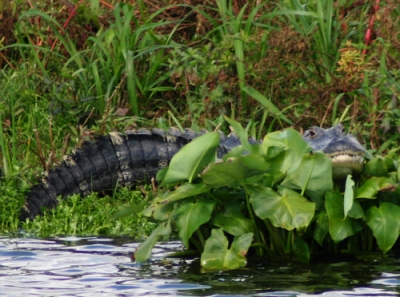
Digesting...
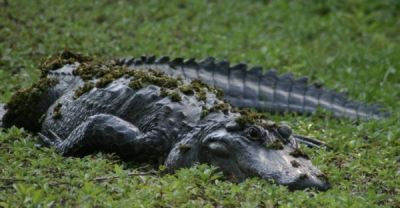
'Gator's love fish!
Please excuse the quality of the film. I zoomed a bit too much as I tried to see what it was the alligator was eating.
I get a lot of readers who are interested in alligator behavior. We all "get" the alligator; we just want to know what makes it tick. As I watch these fascinating animals I ask questions. I hope the answers I find help answer readers questions.
Behavior
Alligator Communication
Alligators hiss, bellow, roar, and produce subaudible sounds. The adults also communicate by snapping their jaws or slamming their heads downward. Adults raise their heads out of the water when meeting another.
The young make several different sounds including distress yelping when in danger, a soft churp when greeting a mother and a deeper churping when they are hatching.
Most of these studies on alligator communication has been done with captive animals. Kent Vliet studied alligators at the St. Augustine Alligator Farm in 1989. He observed the courtship behavior of alligators and describes 4 positions during the courtship bellowing. 1) Inhaling which can raise the head and body more out of the water. 2) Lowering the body into the water 3) Creating subaudible sounds which produce a splattering of water drops. 4) Raising the head out of the water to produce an audible bellow.
The animals observed, video taped and photographed here are wild and cover a longer period of time than Kent Vliet's. Some of the video of alligators shown here may be behavior not documented before.
I am sure it's been seen before. Humans and alligators have lived together for a very long time but it may not have been seen by you, or me, or documented on film yet.
Territorial Display
A large male displays in the early morning hours in July at about 6:30 a.m. on July 18. The breeding season is over. This alligator raises his body out of the water and splashes back down then roars.
Alligator Behavior - Jaw Snap & Hiss
I watched this alligator for nearly an hour as it hunted the banks. It had just crawled very slowly out from under a fireflag plant that it had slipped under 10 minutes earlier when it was discovered by several birds. These birds are giving the alarm. The alligator raised it's head and gave a hiss. It's difficult to catch. You can hear the sound just after the alligator raises it's head and just before the zoom. The alligator then snapped it's jaws and swam away.
It appeared to me that the alligator was frustrated. I would have been too if I was hungry and had been hunting for such a long time just to have the hunt ruined. The jaw snap surprised me. I apologize for the shaking of the camera. I wasn't very far away and it was quite startling. The video is dark as I was shooting from the sun into the deep shade of the underbrush. It was early morning, about 8 a.m.
Kent Vliet describes this action as a "threat call" (hiss and bite) but there were no other alligators around. The only other creatures around were the birds that had come in and given the alarm.
Snap & Hiss - Again
I had followed this alligator for nearly 2 hours as she swam around an open water marsh. She had made a few attempts to catch fish and to sneak up on birds at the waters edge but was unable to catch dinner. I know she was doing this yesterday as well so I assume she had been hunting for nearly two days. She crawled under the boardwalk and after a long time gave a low hiss and snapped her jaws. This hiss is difficult to hear on the video bit I heard it and that's why I zoomed in on her. Again, no other alligators around except the small one that had left the area quickly about 45 minutes earlier. This is the second time I've seen this behavior from females who had failed in their hunting. I didn't shake the camera this time! I'm learning.
A little story about a mother alligator and her territory. - Part 1
I was walking along the boardwalk and stopped at a little gazebo area when I spotted a younger female alligator at the edge of the reeds. She was about 15 feet away and not at all happy about the people walking over her territory. I stopped because she was displaying and if I had continued to walk I would be moving towards her. I didn't think she'd like that. Her "snap" unsettled me a bit and I shook the camera. If you're ever near an alligator when they do this it's rather impressive. Then she came towards me and I backed up. You can see how close I was to her as I back up and the railing comes into view.
A little story about a mother alligator and her territory. - Part 2
She went under my feet and stopped. I stayed where I was. She was being very aggressive and warning me. Maybe even aggressive enough to charge the boardwalk though I doubt very much if she would have. Just in case, the gazebo gave me more room to move if she had tried. The boardwalk is only about 4 feet wide. The gazebo is much wider.
I stood there and wondered what she would do next. She was just two feet under my toes and I could see her through the cracks in the boardwalk. Then she started to roar.
Have you ever been swimming in a lake and gone under a pier? If you talk to someone under there the sound is very loud. With the combination of the water, the confined space and the wood of the boardwalk as well as being just two feet under me, the sound was tremendously loud. She was also answered by another alligator farther away but you can't hear it on the video.
Turn your speakers up high and you'll get close to the sound. You can also hear the small splashes she makes as she lowers herself back down into the water after each roar.
I was greatly impressed.
Passive Fear Response
The zoologist Norbert Smith's discovery of how alligators react to fear is a remarkable story. He radio collared an alligator and let it loose into the wild. Most studies on alligators are done in the lab or at alligator farms. He wanted to study one that was not influenced by human environments. The standard thought was that alligators heart rates lowered when submerged. The first thing Smith discovered was that his alligator, out in the wild, did not lower it's heart rate when it submerged. This wasn't what he was trying to study but it was what he discovered and it ran counter to everything everyone thought. He was trying to understand why his alligator did not do what all the other alligators studied did when another biologist passed close to Smiths alligator. The alligator responded to this intrusion by dropping under the water and lowering it's heart rate.
Smith discovered that this fact that everyone thought was true was affected by the very means that researchers had used to study the animals. That is, captivity influenced the study results.
To cause this response the alligator needs to be in an area of relative safety when the human approaches. Smith went on to studying other animals including mammals and discovered that many animals also have a passive fear response of slowing movement and dropping heart rate.
So, when you see an alligator drop under the water while hunting it's heart rate isn't dropping. If you come up close to an alligator and he sinks under the water in response to you he is feeling fear and his heart rate drops.
Or maybe he's hunting you. It's never a good thing to assume anything with an alligator.
A little about studies on captive alligators.
Alligators on alligator farms are different behaviorally as well as physically from wild alligators. Studies done on captive alligators need to have this calculated into the results. Studies are often done on captive alligators mainly because it's easier to study these animals if they are in a confined and controlled area.
Norbert Smith (Passive Fear Response above) discovered this accidentally while studying alligators in the wild and he ended up disproving a long standing "fact" that had been determined by studying captive alligators.
Gregory Erickson discovered that captive alligators heads were different than wild alligators and this affected the bite force of the animal resulting in captive alligators having a stronger bite force than wild.
Ok, we're only talking a few hundred psi and I would think that the difference between 1,200 psi and 1,500 psi really doesn't make much difference if the alligator has his teeth on you but the fact that alligators on alligator farms are physically different from wild alligators is an interesting thought. Just the fact that alligators have this much ability to change depending on their environments shows that alligators are a bit more adaptable than we may realize. Are alligators in the smaller preserves surrounded by human development different than alligators out in the wilds of the Everglades? Even though these animals are wild and not confined does living so close to humans actually change them?
There's a lot about alligators that we don't know and each discovery brings more questions.
Unusual Behavior
Out of Season Mating - Never before recorded behavior.
Alligators mate in the spring. Here are two mating in October. James Perran Ross at the Department of Wildlife Ecology and Conservation, University of Florida concurs that the alligators are breeding and he is as surprised as I was to see it. We don't know why yet but I do know this alligators nest didn't hatch this year. Both the 9 foot female and the 12 male are long time residents of the area and would be, as much as alligators are, pair bonded.
An alligator chases a turtle
I have no idea what the alligator is doing here chasing a turtle. It doesn't seem to want to eat it. I know this is the smaller female that had her nest in this same area. Maybe she's protecting the nest. It's not a very serious chase though. Maybe she considered eating the turtle and decided not to. Many of the video's I have up here are of this alligator. She's roared under my feet on the boardwalk. She's hissed and snapped in frustration. She's the alligator who had a turtle just a little too big to eat. The curious rabbit was an interesting aspect of this little drama.
Mating & Raising Young
Alligator show
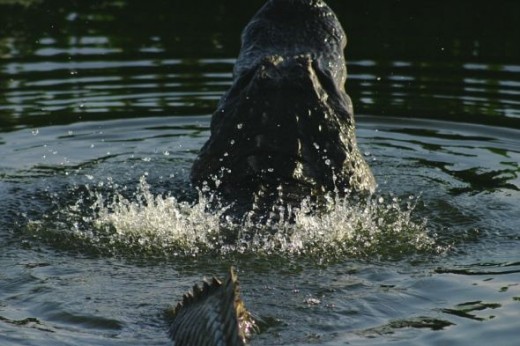
Male alligators 'dance' to attract females and establish territory. Here a male is 'dancing' to attract two females that are nearby. The alligator rises up then lowers his body halfway and roars. The roar drops in volume until water drops bounce on his back, then he will drop farther into the water with a small splash.
'Gator Love

Alligator babies
The alligators breeding season begins in April and goes through June. The courtship rituals of the alligator are quite complex, involving touching, rubbing, the blowing of bubbles and vocalizations. The actual mating takes place in open water. Alligators are not monogamous but they have been known to "prefer" one male over another. James Perran Ross of the Department of Wildlife Ecology and Conservation, University of Florida tells me that "We know from DNA studies that females are inseminated by a number of males and can store sperm for months to years, so that each batch of eggs often has more than one father involved. It is also normal for females to not nest every year but take a year or two off occasionally, although sometimes nesting in sequential years - depends a little on the food supply and how fat she can get."
Male alligators are territorial during the breeding season, and will defend their area against other male intruders.
After mating the female alligator moves into the marshy areas and shoreline where she will build a nest. They lay their eggs in late June and early July and will lay about 15-60 eggs, but the number depends on the age of the female. The incubation period of the eggs is 60 to 70 days with 65 days the norm. The sex of the juveniles is determined by the temperature of the nest: above 93° F all are male, below 86° F all are female, and temperatures in between will produce both sexes. The top of the nest is usually warmer and produce males. The bottom of the nest is usually cooler and produce females.
In Florida nesting success is usually about 50%.
The female alligator guards her nest against intruders while they are incubating. Towards the end of August the young alligators begin to make high-pitched noises from inside of the egg. This alerts the mother who removes the nesting vegetation. When the babies are born they are about 6-8 inches.
The hatchling alligators form groups called pods and may stay in the same vicinity of their nesting site for several years. Until the next breeding season begins, the female alligator will remain near her brood, defending them against predators yet despite this advantage almost 80% of hatchlings die within the first two years of life. Almost everything - from herons to snakes, otters and even large fish and other alligators - eat them.
'Gator love leads to little alligators.
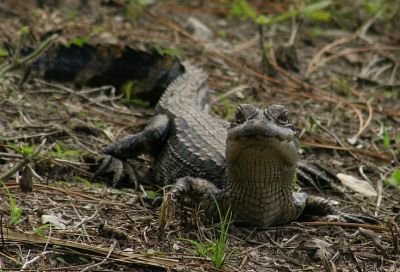
Mama alligator makes the swimming hole deeper for her babies.
Mama Alligator with her babies
Such small creatures compared to mama!
A newly hatched young swims for cover in the reeds
A mother alligator watches over her young.
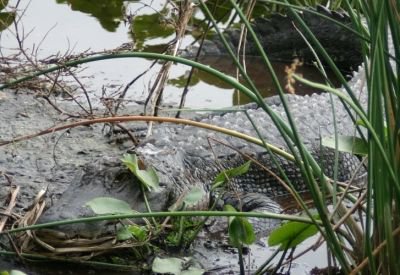
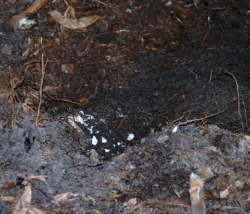
Alligator predators
Mother alligators need to watch their nests carefully. There are many creatures who will break into the nest and eat the eggs. The mortality rate for hatched alligators is about 50% in the first year. Young are eaten by birds such as Blue Herons and Egrets and by fish such as Bass. They are also eaten by other alligators. This nest may have been broken into by a snapping turtle, snake, or raccoon. The holes that were dug into the nest was large so I'm guessing it was raccoons that got the eggs.
Tri-colored Heron with an attitude
You would think this Tri-color Heron was sending a message to the alligator.
Actually, birds do this just before they are about to fly. Every smidgen of weight matters. It's nice to know this if you want to photograph birds. If you see them do this be ready to shoot some birds in flight photos.
Tracking An Alligator
A walk on the wild side. - Reading the sign in the dirt.
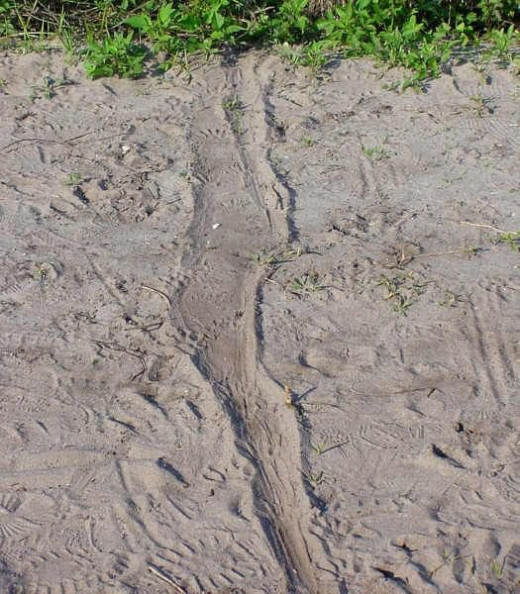
Now, let's find out what happened here...
There is a lot to tell about this little bit of dirt. It's pretty trampled but we can get valuable clues from the different tracks here. Let me first give you a bit of basic information: This is an alligator's track and the long line is the alligators tail dragging.
First, let's find out how big the alligator was.
At the bottom of the photo is a man's boot track. The boot track was the size of an average man which is about a foot or 12 inches long. Now you have a measurement to use against all the other sign you see here.
You can get a small indication of this gators size by the tail drag track near the boot. It's deeper than the man's so it's heavier than a man. The track is also at least 3 or 4 inches wide even with the small wiggle (that you can see in the ripple of the dirt) and it was deep. The tail was bigger AND heavier.
If you scan your eyes from this spot on up the gators track you'll notice that it gets lighter and wiggles more. As the gator entered the edge of the brush and started down the bank his tail lifted. He also wiggled more as his front feet and then his back feet started down the bank. You can see this in the widening of the track as it moves up in the photo.
Before we go on to more about the alligator it's self let's look at the other track near the boot print. These are raccoon tracks. They're the raccoons front paws. His back paws are on this photo as well. They're the smaller more rounded tracks you might see in the photo if you have a good eye. In this sandy soil you might mistake the back paws for dog prints. Knowing that raccoons are out at night and not during the day will help place the time that the gator made his track. You can see that the raccoons track pushed dirt into the tail track so had to have been made after the gator made his. You'll also notice that this racoon has walked inside the gators tail track.
"Ok", you're saying now, "What about the gator? Where are HIS footprints?".
Well, you've spotted the humans boot print. And working from there towards the right you see the gators tail track, then the raccoons footprint overlapping the gators tail track, and right after that is the gators paw print. Yes that is the gators paw print and yes, if you compare it to the humans print, it IS a big paw. It is also much heavier than a full grown man as it makes a much deeper print. I told you this was a big gator.
And now that you can recognize this gators paw print you can see it all the way up the photo on either side of the tail track.
I think this was one alligator I was glad not to meet!
Sleeping soundly.
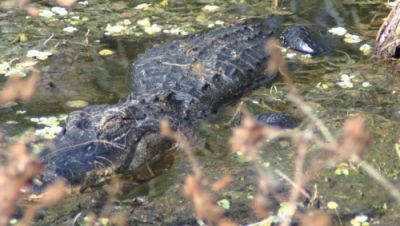
Ah... He's not quite sleeping.
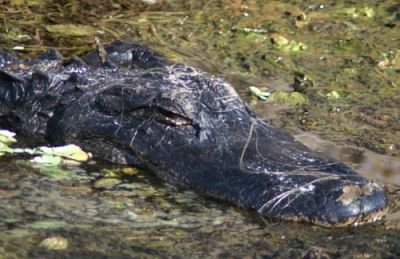
Rule #1:
If you meet an alligator remember this...
Alligators always have the right of way
Give them at least 30 feet clearance
The rest of the rules
Rule #2: Don't harass an alligator.
Don't make sounds at it, pound the ground, toss things, try to get it's attention in any way or try to make it move.
Once an alligator charges you then you'll understand why you don't do these things. Alligators don't eat people and will leave you alone if you leave it alone. Harass it and it'll charge. I've seen people harassing an alligator. They keep it up until the alligator reacts. I've never seen them stand in one spot and say "Oh cool" when the alligator reacts. All I see of the people are their backsides as they're running away.
A charging alligator is extremely impressive and something you don't want to see coming at you. So... Don't mess with the alligators.
Rule #3: Stay back.
Alligators are never sleeping. They are always aware of what's going on around them and will react to things. And when they react they react very, very quickly. From "sleeping" to "Food in the mouth" is less than 0.01 seconds so... stay back.
DO NOT BRING YOUR PET
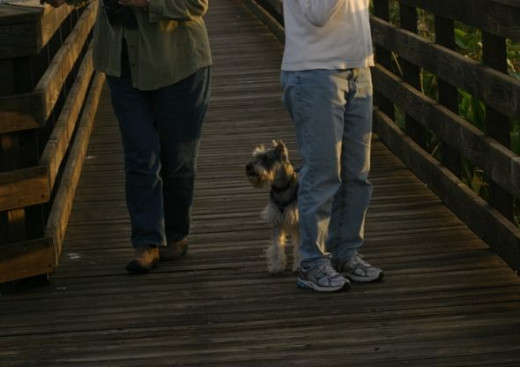
You endanger your pet because an alligator will definitely eat it. You also endanger other people and the alligators themselves.
It works this way:
We humans are safe on the board walk only because the alligators do not see us as food.
As soon as someone brings a dog and an alligator finds it easy prey the alligator will now consider creatures on the boardwalk as food.
Both the 9 foot female and the 13 foot male could easily eat a full grown man. And they would if they saw us as food.
If this happened they would remove the large alligators from the preserve and kill them.
They don't remove them "somewhere safe". Alligators removed from confrontations with humans are killed and turned it to meat and hide. That's why the trappers come out to peoples pools and back yards. They get to keep the gator.
The alligators brain is only as big as a kidney bean. They're all instinct. We're supposed to be the ones with the brains.
DO NOT BRING YOUR PET
Crazy about alligators? Learn more about them from these books.
Great sites for more learning.
It's not easy to find sites that don't just rehash what everyone else says about alligators. Forget online encyclopedias and 98% of all websites devoted to alligators. They all repeat the same information.
The following links will give you real data. Most are not for the faint of heart but if you want to take that extra step beyond to learn even more about alligators be sure to explore these resources.
- The Journal of Experimental Biology
Back issues are free and it has a search. You can find articles like: Death roll of the alligator: mechanics of twist feeding in water, The tale of the tail: limb function and locomotor mechanics in Alligator mississippiensis, and Structure and funct - BioOne
BioOne is a global, not-for-profit collaboration bringing together scientific societies, publishers, and libraries to provide access to critical, peer-reviewed research in the biological, ecological, and environmental sciences. It has some great art



